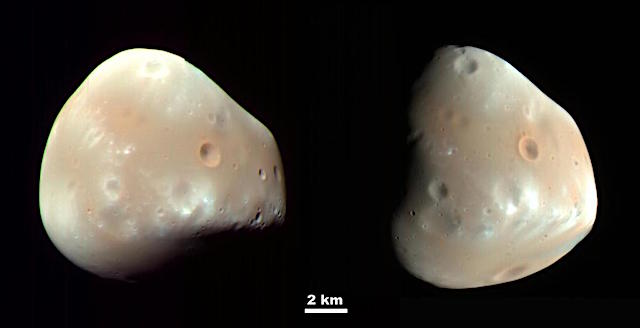 Sols 2349-51, March 18, 2019, update by MSL scientist Catherine O’Connell-Cooper: The Curiosity Operations team planned a 3-sol plan today, with lots of activities for both the Environmental (ENV) and Geology (GEO) theme groups. Top priority for ENV and Mastcam is to record a rare solar transit by Deimos (the smaller of the two martian moons) on sol 2350. This is similar to a lunar eclipse here on Earth; however, as Deimos is very small (radius of 6 km), it will not block out the Sun but appear as a dark spot on the solar disk. Although Curiosity has recorded 13 transits by Phobos (Mars’ second moon) within the past six years, we have previously only captured one recording of Deimos crossing in front of the Sun, on sol 42.
Sols 2349-51, March 18, 2019, update by MSL scientist Catherine O’Connell-Cooper: The Curiosity Operations team planned a 3-sol plan today, with lots of activities for both the Environmental (ENV) and Geology (GEO) theme groups. Top priority for ENV and Mastcam is to record a rare solar transit by Deimos (the smaller of the two martian moons) on sol 2350. This is similar to a lunar eclipse here on Earth; however, as Deimos is very small (radius of 6 km), it will not block out the Sun but appear as a dark spot on the solar disk. Although Curiosity has recorded 13 transits by Phobos (Mars’ second moon) within the past six years, we have previously only captured one recording of Deimos crossing in front of the Sun, on sol 42.
GEO’s main geological target today (“Caledonia”) comprises three separate targets (1 cm apart) across a mixture of sand and pebbles, to help us determine the origin of the rubbly material found across this part of Gale crater. ChemCam will focus on a pebble here, APXS will analyze each of the three spots, and MAHLI will image each spot. Mastcam will take a multi-spectral image of the whole target to aid in interpreting the results. In addition, APXS will analyze a brushed bedrock target (“Arbuthnott”) and ChemCam will examine some soil (“Buzzard”) and an area of small pebbles (“Gardenstown”). Once we have finished investigating the geology of this location, we drive to a block of tilted rock, 12 metres away, called “Muir of Ord.” [More at link]








